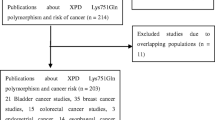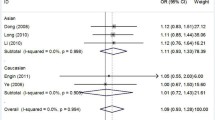Abstract
Published data on the association between three polymorphisms (Lys939Gln, Ala499Val, and PAT±) of Xeroderma Pigmentosum group C (XPC) and breast cancer risk are inconclusive. To derive a more precise estimation of the relationship, a meta-analysis was performed. Crude ORs with 95% CIs were used to assess the strength of association between them. A total of 11 studies including 5,090 cases and 5,214 controls were involved in this meta-analysis. For XPC Lys939Gln polymorphism, no obvious associations were found for all genetic models when all studies were pooled into the meta-analysis (Lys/Gln vs. Lys/Lys: OR = 1.00, 95% CI 0.92–1.10; Gln/Gln vs. Lys/Lys: OR = 0.96, 95% CI 0.84–1.09; dominant model: OR = 0.99, 95% CI 0.91–1.08; and recessive model: OR = 0.97, 95% CI 0.86–1.09). In the subgroup analysis by ethnicity or study design, still no obvious associations were found. For XPC Ala499Val polymorphism, also no obvious associations were found for all genetic models when all studies were pooled into the meta-analysis (Val/Ala vs. Ala/Ala: OR = 0.91, 95% CI 0.79–1.05; Val/Val vs. Ala/Ala: OR = 1.07, 95% CI 0.80–1.44; dominant model: OR = 0.93, 95% CI 0.81–1.06; and recessive model: OR = 1.11, 95% CI 0.84–1.48). For XPC PAT± polymorphism, obvious associations were found for recessive model when all studies were pooled into the meta-analysis (OR = 1.41, 95% CI 1.05–1.89). In conclusion, this meta-analysis suggests that the XPC PAT± polymorphism allele may be a low-penetrant risk factor for developing breast cancer.
Similar content being viewed by others
References
Parkin DM, Bray F, Ferlay J, Pisani P (2005) Global cancer statistics 2002. CA Cancer J Clin 55:74–108
Pharoah PD, Dunning AM, Ponder BA, Easton DF (2004) Association studies for finding cancer-susceptibility genetic variants. Nat Rev Cancer 4:850–860
Qiu LX, Zhang J, Zhu XD, Zheng CL, Sun S, Wang ZH (2010) The p21 Ser31Arg polymorphism and breast cancer risk: a meta-analysis involving 51, 236 subjects. Breast Cancer Res Treat 124:475–479
Qiu LX, Yao L, Zhang J, Zhu XD, Zhao XM, Xue K (2010) XPD Lys751Gln polymorphism and breast cancer susceptibility: a meta-analysis involving 28, 709 subjects. Breast Cancer Res Treat 124:229–235
Qiu LX, Yao L, Mao C, Chen B, Zhan P, Xue K (2010) TGFB1 L10P polymorphism is associated with breast cancer susceptibility: evidence from a meta-analysis involving 47, 817 subjects. Breast Cancer Res Treat 123:563–567
Qiu LX, Yao L, Xue K, Zhang J, Mao C, Chen B (2010) BRCA2 N372H polymorphism and breast cancer susceptibility: a meta-analysis involving 44, 903 subjects. Breast Cancer Res Treat 123:487–490
Araki M, Masutani C, Takemura M (2001) Centrosome protein centrin 2/caltractin 1 is part of the xeroderma pigmentosum group C complex that initiates global genome nucleotide excision repair. J Biol Chem 276:18665–18672
Sugasawa K, Shimizu Y, Iwai S, Hanaoka F (2002) A molecular mechanism for DNA damage recognition by the xeroderma pigmentosum group C protein complex. DNA Repair 1:95–107
Khan SG, Metter EJ, Tarone RE (2000) A new xeroderma pigmentosum group C poly(AT) insertion/deletion polymorphism. Carcinogenesis 21:1821–1825
Smith TR, Levine EA, Freimanis RI, Akman SA, Allen GO, Hoang KN (2008) Polygenic model of DNA repair genetic polymorphisms in human breast cancer risk. Carcinogenesis 29:2132–2138
Shen J, Gammon MD, Terry MB, Teitelbaum SL, Eng SM, Neugut AI (2008) Xeroderma pigmentosum complementation group C genotypes/diplotypes play no independent or interaction role with polycyclic aromatic hydrocarbons-DNA adducts for breast cancer risk. Eur J Cancer 44:710–717
Jorgensen TJ, Visvanathan K, Ruczinski I, Thuita L, Hoffman S, Helzlsouer KJ (2007) Breast cancer risk is not associated with polymorphic forms of xeroderma pigmentosum genes in a cohort of women from Washington County, Maryland. Breast Cancer Res Treat 101:65–71
Mechanic LE, Millikan RC, Player J (2006) Polymorphisms in nucleotide excision repair genes, smoking and breast cancer in African Americans and whites: a population-based case-control study. Carcinogenesis 27:1377–1385
Zhang L, Zhang Z, Yan W (2005) Single nucleotide polymorphisms for DNA repair genes in breast cancer patients. Clin Chim Acta 359:150–155
Forsti A, Angelini S, Festa F (2004) Single nucleotide polymorphisms in breast cancer. Oncol Rep 11:917–922
Shen J, Desai M, Agrawal M (2006) Polymorphisms in nucleotide excision repair genes and DNA repair capacity phenotype in sisters discordant for breast cancer. Cancer Epidemiol Biomarkers Prev 15:1614–1619
Shore RE, Zeleniuch-Jacquotte A, Currie D, Mohrenweiser H, Afanasyeva Y, Koenig KL (2008) Polymorphisms in XPC and ERCC2 genes, smoking and breast cancer risk. Int J Cancer 122:2101–2105
Cochran WG (1954) The combination of estimates from different experiments. Biometrics 10:101–129
Mantel N, Haenszel W (1959) Statistical aspects of the analysis of data from retrospective studies of disease. J Natl Cancer Inst 22:719–748
DerSimonian R, Laird N (1986) Meta-analysis in clinical trials. Control Clin Trials 7:177–188
Tobias A (1999) Assessing the influence of a single study in the meta-analysis estimate. Stata Tech Bull 8:15–17
Egger M, Davey Smith G, Schneider M, Minder C (1997) Bias in meta-analysis detected by a simple, graphical test. BMJ 315:629–634
Taylor SJ, Tweedie RI (1998) Practical estimates of the effect of publication bias in meta- analysis. Australas Epidemiologist 5:14–17
Khan SG, Muniz-Medina V, Shahlavi T (2002) The human XPC DNA repair gene: arrangement, splice site information content and influence of a single nucleotide polymorphism in a splice acceptor site on alternative splicing and function. Nucleic Acids Res 30:3624–3631
Marin MS, Lopez-Cima MF, Garcia-Castro L, Pascual T, Marron MG, Tardon A (2004) Poly (AT) polymorphism in intron 11 of the XPC DNA repair gene enhances the risk of lung cancer. Cancer Epidemiol Biomarkers Prev 13:1788–1793
Sak SC, Barrett JH, Paul AB, Bishop DT, Kiltie AE (2005) The polyAT, intronic IVSII-6 and Lys939Gln XPC polymorphisms are not associated with transitional cell carcinoma of the bladder. Br J Cancer 92:2262–2265
Qiao Y, Spitz MR, Shen H, Guo Z, Shete S, Hedayati M (2002) Modulation of repair of ultraviolet damage damage in the host-cell reactivation assay by polymorphic XPC and XPD/ERCC2 genotypes. Carcinogenesis 23:295–299
Hirschhorn JN, Lohmueller K, Byrne E (2002) A comprehensive review of genetic association studies. Genet Med 4:45–61
Author information
Authors and Affiliations
Corresponding author
Rights and permissions
About this article
Cite this article
Zheng, W., Cong, XF., Cai, WH. et al. Current evidences on XPC polymorphisms and breast cancer susceptibility: a meta-analysis. Breast Cancer Res Treat 128, 811–815 (2011). https://doi.org/10.1007/s10549-011-1369-6
Received:
Accepted:
Published:
Issue Date:
DOI: https://doi.org/10.1007/s10549-011-1369-6




